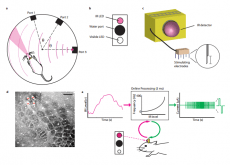Infrared signaling could create sense of touch in artificial limbs
Rats can’t usually see infrared light, but they have “touched” it in a Duke University lab.
The rats sensed the light as a sensation of touch after Duke neurobiologist Miguel Nicolelis and his team fitted the animals with an infrared detector wired to electrodes implanted in the part of the mammalian brain that processes information related to the sense of touch.
One of the main flaws of current human, brain-controlled prosthetics is that patients cannot sense the texture of what they touch, Nicolelis said. His goal is to give quadriplegics not only the ability to move their limbs again, but also to sense the texture of objects placed in their hands or experience the nuances of the terrain under their feet.
His lab studies how to connect brain cells with external electrodes for brain-machine interfaces and neural prosthetics in human patients and non-human primates, giving them the ability to control limbs, both real and virtual, using only their minds. He and his team have shown that monkeys, without moving any part of their real bodies, could use their electrical brain activity to guide the virtual hands of an avatar to touch virtual objects and recognize their simulated textures.
His latest study, published Feb. 12 in Nature Communications, shows that the rats’ cortexes respond both to the simulated sense of touch created by the infrared light sensors and to whisker touch, as if the cortex is dividing itself evenly so that the brain cells process both types of information.
This plasticity of the brain counters the current “optogenetic” approach to brain stimulation, which suggests that a particular neuronal cell type should be stimulated to generate a desired neurological function. Instead, stimulating a broader range of cell types might help a cortical region adapt to new sensory sources, Nicolelis said.
His team recently documented the firing patterns of nearly 2,000 individual, interconnected neurons in monkeys. Recording the electrical activity from thousands of neurons at once is important for improving the accuracy and performance of neuroprosthetic devices, he said.
This brain-machine interface work is all part of an international effort called the Walk Again Project to build a whole-body exoskeleton that could help paralyzed people regain motor and sensory abilities using brain activity to control the apparatus. He and his collaborators expect to first use the exoskeleton in the opening ceremony of the FIFA Soccer World Cup in June 2014.
Duke University & EurekAlert
The Latest Streaming News: Brain prostheses create a sense of touch updated minute-by-minute
Bookmark this page and come back often
Latest NEWS
Latest VIDEO








